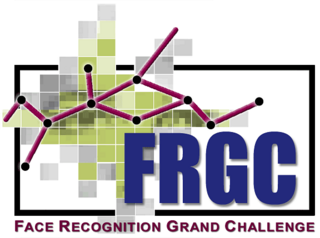The National Nanotechnology Initiative (NNI) is a research and development initiative which provides a framework to coordinate nanoscale research and resources among United States federal government agencies and departments.

The Text REtrieval Conference (TREC) is an ongoing series of workshops focusing on a list of different information retrieval (IR) research areas, or tracks. It is co-sponsored by the National Institute of Standards and Technology (NIST) and the Intelligence Advanced Research Projects Activity, and began in 1992 as part of the TIPSTER Text program. Its purpose is to support and encourage research within the information retrieval community by providing the infrastructure necessary for large-scale evaluation of text retrieval methodologies and to increase the speed of lab-to-product transfer of technology.
The Facial Recognition Technology (FERET) database is a dataset used for facial recognition system evaluation as part of the Face Recognition Technology (FERET) program. It was first established in 1993 under a collaborative effort between Harry Wechsler at George Mason University and Jonathon Phillips at the Army Research Laboratory in Adelphi, Maryland. The FERET database serves as a standard database of facial images for researchers to use to develop various algorithms and report results. The use of a common database also allowed one to compare the effectiveness of different approaches in methodology and gauge their strengths and weaknesses.
TIMIT is a corpus of phonemically and lexically transcribed speech of American English speakers of different sexes and dialects. Each transcribed element has been delineated in time.
The Common Criteria model provides for the separation of the roles of evaluator and certifier. Product certificates are awarded by national schemes on the basis of evaluations carried by independent testing laboratories.

The National Science and Technology Council (NSTC) is a council in the Executive Branch of the United States. It is designed to coordinate science and technology policy across the branches of federal government.
According to the DHS S&T website, the Command, Control, and Interoperability Division was a unit of the DHS Science and Technology Directorate which "develops interoperable communication standards and protocols for emergency responders, cyber security tools for protecting the integrity of the Internet, and automated capabilities to recognize and analyze potential threats."
The Facial Recognition Technology (FERET) program was a government-sponsored project that aimed to create a large, automatic face-recognition system for intelligence, security, and law enforcement purposes. The program began in 1993 under the combined leadership of Dr. Harry Wechsler at George Mason University (GMU) and Dr. Jonathon Phillips at the Army Research Laboratory (ARL) in Adelphi, Maryland and resulted in the development of the Facial Recognition Technology (FERET) database. The goal of the FERET program was to advance the field of face recognition technology by establishing a common database of facial imagery for researchers to use and setting a performance baseline for face-recognition algorithms.

Multiple Biometric Grand Challenge (MBGC) is a biometric project. Its primary goal is to improve performance of face and iris recognition technology on both still and video imagery with a series of challenge problems and evaluation.

The Face Recognition Grand Challenge (FRGC) was conducted from May 2004 until March 2006 to promote and advance face recognition technology. The FRGC v2 database created in 2005 has had a significant impact on the development of 3D face recognition. Although many other face databases have been created since then, as of 2022, FRGC v2 continued to be used as "a standard reference database for evaluating 3D face recognition algorithms".

The Face Recognition Vendor Test (FRVT) was a series of large scale independent evaluations for face recognition systems realized by the National Institute of Standards and Technology in 2000, 2002, 2006, 2010, 2013 and 2017. Previous evaluations in the series were the Face Recognition Technology (FERET) evaluations in 1994, 1995 and 1996. The project is now in an Ongoing status with periodic reports, and continues to grow in scope. It now includes tests for Face-in-Video-Evaluation (FIVE), facial morphing detection, and testing for demographic effects.
Smart grid policy in the United States refers to legislation and other governmental orders influencing the development of smart grids in the United States.
IDEMIA is a multinational technology company headquartered in Courbevoie, France. It provides identity-related security services, and sells facial recognition and other biometric identification products and software to private companies and governments.

The MNIST database is a large database of handwritten digits that is commonly used for training various image processing systems. The database is also widely used for training and testing in the field of machine learning. It was created by "re-mixing" the samples from NIST's original datasets. The creators felt that since NIST's training dataset was taken from American Census Bureau employees, while the testing dataset was taken from American high school students, it was not well-suited for machine learning experiments. Furthermore, the black and white images from NIST were normalized to fit into a 28x28 pixel bounding box and anti-aliased, which introduced grayscale levels.
The Cyber Resilience Review (CRR) is an assessment method developed by the United States Department of Homeland Security (DHS). It is a voluntary examination of operational resilience and cyber security practices offered at no cost by DHS to the operators of critical infrastructure and state, local, tribal, and territorial governments. The CRR has a service-oriented approach, meaning that one of the foundational principles of the CRR is that an organization deploys its assets to support specific operational missions. The CRR is offered in a facilitated workshop format and as a self-assessment package. The workshop version of the CRR is led by a DHS facilitator at a critical infrastructure facility. The workshop typically takes 6–8 hours to complete and draws on a cross section of personnel from the critical infrastructure organization. All information collected in a facilitated CRR is protected from disclosure by the Protected Critical Infrastructure Information Act of 2002. This information cannot be disclosed through a Freedom of Information Act request, used in civil litigation, or be used for regulatory purposes. The CRR Self-Assessment Package allows an organization to conduct an assessment without the need for direct DHS assistance. It is available for download from the DHS Critical Infrastructure Cyber Community Voluntary Program website. The package includes an automated data answer capture and report generation tool, a facilitation guide, comprehensive explanation of each question, and a crosswalk of CRR practices to the criteria of the National Institute of Standards and Technology (NIST) Cybersecurity Framework. The questions asked in the CRR and the resulting report are the same in both versions of the assessment. DHS partnered with the CERT Division of the Software Engineering Institute at Carnegie Mellon University to design and deploy the CRR. The goals and practices found in the assessment are derived from the CERT Resilience Management Model (CERT-RMM) Version 1.0. The CRR was introduced in 2009 and received a significant revision in 2014.

The Inter-university Consortium for Political and Social Research (ICPSR) is an American political science and social science research consortium, based at the University of Michigan. It was founded in 1962. An integral part of the infrastructure of social science research, ICPSR maintains and provides access to a vast archive of social science data for research and instruction.
Amazon Rekognition is a cloud-based software as a service (SaaS) computer vision platform that was launched in 2016. It has been sold to, and used by, a number of United States government agencies, including U.S. Immigration and Customs Enforcement (ICE) and Orlando, Florida police, as well as private entities.

Neurotechnology is an algorithm and software development company founded in Vilnius, Lithuania in 1990.

Elham Tabassi is an engineer and government leader. She was listed on the inaugural TIME100 Most Influential People in AI. Tabassi led the creation of the United States Artificial Intelligence Risk Management Framework, adopted by both industry and government. Tabassi was selected to serve on the National Artificial Intelligence (AI) Research Resource Task Force. Tabassi began her career in government at the National Institute of Standards and Technology, pioneering various machine learning and computer vision projects with applications in biometrics evaluation and standards, included in over twenty five publications. Her research has been deployed by the FBI and Department of Homeland Security.










